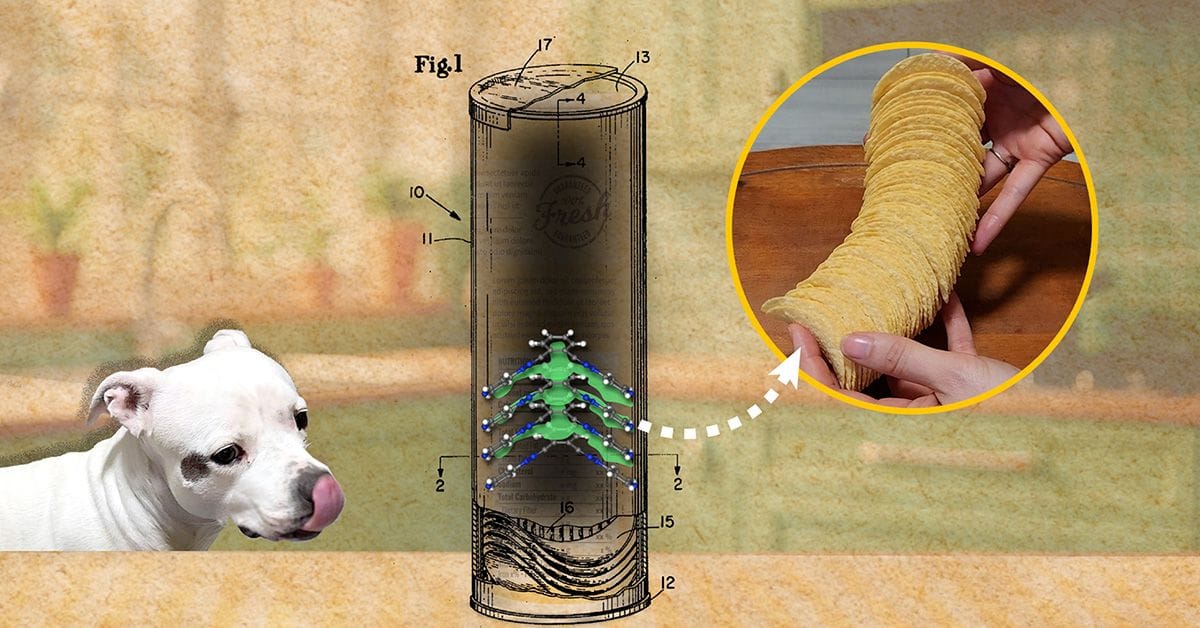Just as Pringles owe their perfect stack to a clever curve, molecular crystals need precise geometry to work in real-world applications. See how one team is reimagining molecular architecture for next-generation materials.

Molecular crystals offer properties that single molecules can’t achieve, such as long-range energy transfer and unique electronic behavior. These advantages depend on how well the building blocks are arranged, and chemists have long worked to control these assembly patterns through careful molecular design.
Achieving both resilience and structural control has remained a challenge. Most molecular crystals are brittle and rigid, limiting real-world applications. And strategies to add flexibility—like incorporating solvent channels, forming cocrystals, or relying on weak dispersive forces—help crystals bend under stress but make precise long-range ordering difficult.
A Pringles-inspired solution
In our world at macroscopic scale, there are plenty of everyday objects that stack well without needing adhesives or mechanical support. Here, curvature is key: flat objects stack poorly, while bent shapes offer more stability. The ideal geometry for stacking is a saddle shape, which locks both translational and rotational movement—just like how Pringles chips stack perfectly together in a can.
Inspired by this "Pringles principle," researchers at Seoul National University have developed a click-to-stack approach that uses saddle-shaped molecules to create elastic crystals with remarkable durability. In the latest Headline Science video, watch as the researchers demonstrate how these macrocycles self-assemble into resilient, waveguiding crystals.
Engineering resilient molecular stacks
By adding different chemical groups to the top and bottom of the molecules, the team made the crystals both tough and adaptable: the upper rim encourages tight stacking, while the lower rim allows the columns to entangle, boosting resilience. As detailed in their recent publication in the Journal of the American Chemical Society, the resulting crystals can bend and stretch under mechanical stress yet maintain their overall structure. When tested as optical waveguides, these elastic crystals showed promise for future use in photonic devices and materials that need to adapt to changing conditions.
Watch more Headline Science on YouTube!
The video above is brought to you by the ACS Science Communications team. To watch more exciting videos and shorts covering some of the latest research in ACS journals, visit the Headline Science page on YouTube.
Video credits:
Written and produced by Anne Hylden
Editing and animations by Janali Thompson
Narrated by Jefferson Beck
Series produced by Vangie Koonce, Anne Hylden, Andrew Sobey, and Jefferson Beck
Executive produced by Matthew Radcliff
Explore related articles from ACS journals
Mechanoresponsive Flexible Crystals
Zhihua Wang, Wenqing Han, Rongchao Shi, Xiao Han, Yongshen Zheng, Jialiang Xu*, and Xian-He Bu*
DOI: 10.1021/jacsau.3c00481
A Supramolecular Nanosheet Assembled from Carpyridines and Water
Joseph F. Woods, Kai Zhang, Joëlle Peterschmitt, Olivier Blacque, Céline Besnard, Gustavo Santiso-Quinones, Laura Samperisi, Andreas Vargas Jentzsch, and Michel Rickhaus*
DOI: 10.1021/jacs.4c17024
Click-To-Twist Strategy To Build Blue-to-Green Emitters: Bulky Triazoles for Electronically Tunable and Thermally Activated Delayed Fluorescence
Hongsik Kim, Youngnam Lee, Hyeonho Lee, Jong-In Hong*, and Dongwhan Lee*
DOI: 10.1021/acsami.1c00278
Small is Beautiful: Electronic Origin and Synthetic Evolution of Single-Benzene Fluorophores
Heechan Kim, Younghun Kim, and Dongwhan Lee*
DOI: 10.1021/acs.accounts.3c00605

